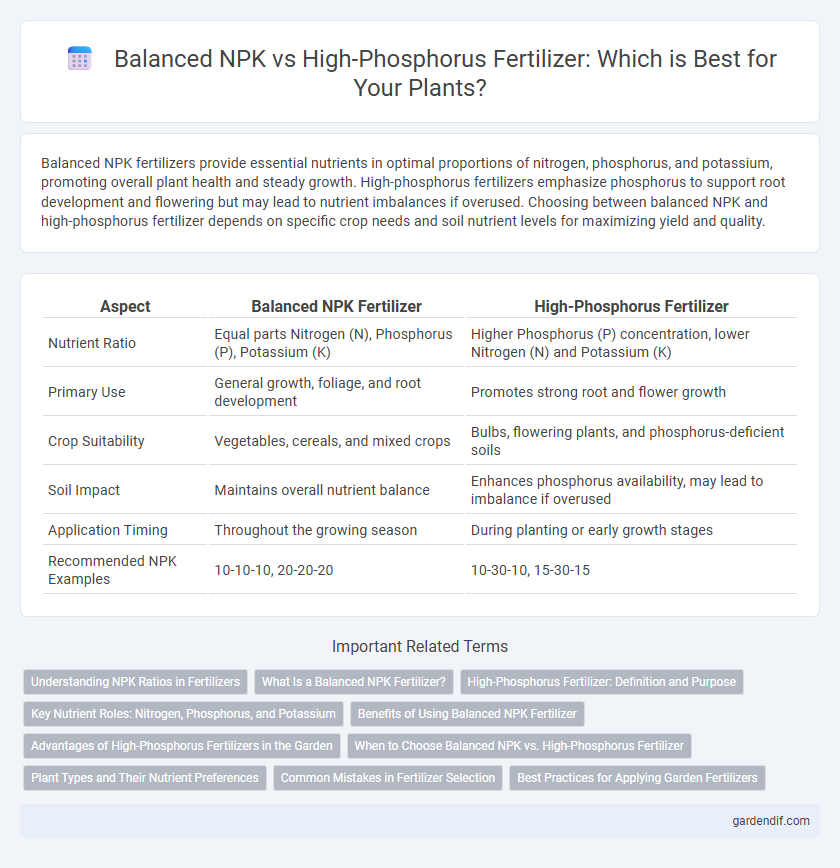
Balanced NPK vs high-phosphorus fertilizer Illustration
Balanced NPK fertilizers provide essential nutrients in optimal proportions of nitrogen, phosphorus, and potassium, promoting overall plant health and steady growth. High-phosphorus fertilizers emphasize phosphorus to support root development and flowering but may lead to nutrient imbalances if overused. Choosing between balanced NPK and high-phosphorus fertilizer depends on specific crop needs and soil nutrient levels for maximizing yield and quality.
Table of Comparison
| Aspect | Balanced NPK Fertilizer | High-Phosphorus Fertilizer |
|---|---|---|
| Nutrient Ratio | Equal parts Nitrogen (N), Phosphorus (P), Potassium (K) | Higher Phosphorus (P) concentration, lower Nitrogen (N) and Potassium (K) |
| Primary Use | General growth, foliage, and root development | Promotes strong root and flower growth |
| Crop Suitability | Vegetables, cereals, and mixed crops | Bulbs, flowering plants, and phosphorus-deficient soils |
| Soil Impact | Maintains overall nutrient balance | Enhances phosphorus availability, may lead to imbalance if overused |
| Application Timing | Throughout the growing season | During planting or early growth stages |
| Recommended NPK Examples | 10-10-10, 20-20-20 | 10-30-10, 15-30-15 |
Understanding NPK Ratios in Fertilizers
Balanced NPK fertilizers contain nitrogen, phosphorus, and potassium in proportions that support overall plant growth, typically represented as ratios like 10-10-10 or 20-20-20, ensuring nutrients are available for roots, foliage, and flowers equally. High-phosphorus fertilizers emphasize phosphorus content, such as 10-30-10, to promote strong root development and flowering but may lack sufficient nitrogen or potassium for other growth stages. Understanding NPK ratios helps gardeners and farmers select fertilizers that match specific plant needs, soil conditions, and growth phases for optimal crop health and yield.
What Is a Balanced NPK Fertilizer?
Balanced NPK fertilizer contains equal or proportionate amounts of nitrogen (N), phosphorus (P), and potassium (K), typically represented by ratios like 10-10-10 or 20-20-20, designed to promote overall plant growth by addressing multiple nutrient requirements simultaneously. This type of fertilizer supports root development, foliage growth, and fruit or flower production by providing essential macro-nutrients in a well-rounded formula. Unlike high-phosphorus fertilizers that emphasize phosphorus to boost root growth and flowering, balanced NPK fertilizers ensure comprehensive nutrition for a variety of crops and soil types.
High-Phosphorus Fertilizer: Definition and Purpose
High-phosphorus fertilizer contains elevated levels of phosphorus, a critical nutrient that supports root development, flowering, and fruiting in plants. It is typically applied during the early growth stages to enhance seedling vigor and promote robust root systems, leading to improved nutrient uptake. Compared to balanced NPK fertilizers, which provide equal proportions of nitrogen, phosphorus, and potassium, high-phosphorus variants target specific growth needs, optimizing yield in phosphorus-deficient soils.
Key Nutrient Roles: Nitrogen, Phosphorus, and Potassium
Nitrogen supports vigorous leaf and stem growth, phosphorus enhances root development and energy transfer, while potassium improves overall plant health and disease resistance. Balanced NPK fertilizers provide these nutrients in optimal ratios tailored to crop requirements, ensuring efficient nutrient uptake and balanced growth. High-phosphorus fertilizers specifically target root establishment and flowering stages but may cause nutrient imbalances if used excessively without adequate nitrogen and potassium.
Benefits of Using Balanced NPK Fertilizer
Balanced NPK fertilizer provides essential nutrients--nitrogen, phosphorus, and potassium--in optimal ratios to promote uniform crop growth and enhance soil fertility. It supports sustainable agriculture by improving nutrient uptake efficiency and reducing the risk of nutrient imbalances or toxicity associated with high-phosphorus fertilizers. Farmers benefit from increased yield quality and better plant resilience, leading to long-term soil health and productivity.
Advantages of High-Phosphorus Fertilizers in the Garden
High-phosphorus fertilizers enhance root development and improve flowering, making them ideal for fruiting plants and early growth stages. They stimulate energy transfer and promote healthy seed and fruit production by providing an abundant supply of phosphorus. Using high-phosphorus fertilizers in the garden supports robust plant establishment and increases crop yield, particularly in phosphorus-deficient soils.
When to Choose Balanced NPK vs. High-Phosphorus Fertilizer
Balanced NPK fertilizers provide essential nitrogen, phosphorus, and potassium in equal or proportional amounts, making them ideal for overall plant growth and development throughout the growing season. High-phosphorus fertilizers are best used during the early stages of plant growth or for root crops, flowering plants, and fruit production to promote strong root development and enhanced bloom formation. Choosing between balanced NPK and high-phosphorus fertilizer depends on soil nutrient levels, plant type, and growth phase to maximize nutrient uptake and crop yield.
Plant Types and Their Nutrient Preferences
Different plant types exhibit distinct nutrient preferences, influencing the choice between balanced NPK and high-phosphorus fertilizers. Leafy vegetables and grasses benefit more from balanced NPK formulations, which provide an equal supply of nitrogen, phosphorus, and potassium essential for overall growth. Flowering and fruiting plants, such as tomatoes and peppers, require higher phosphorus levels to support root development and enhance blooming and fruit production.
Common Mistakes in Fertilizer Selection
Choosing between balanced NPK and high-phosphorus fertilizer often leads to common mistakes such as overemphasizing phosphorus content without considering soil nutrient tests, which can cause nutrient imbalances and poor plant growth. Many gardeners mistakenly apply high-phosphorus fertilizers to soils already rich in phosphorus, neglecting the essential roles of nitrogen and potassium in overall plant health. Proper fertilizer selection requires understanding crop-specific nutrient requirements and soil conditions to avoid excessive phosphorus buildup and ensure balanced nutrient availability.
Best Practices for Applying Garden Fertilizers
Balanced NPK fertilizers provide essential nutrients--nitrogen, phosphorus, and potassium--in optimal ratios that promote overall plant health, root development, and flowering. High-phosphorus fertilizers are beneficial for root establishment but can cause nutrient imbalances if overused, leading to poor plant growth and environmental runoff. Best practices for applying garden fertilizers include soil testing to determine nutrient needs, adhering to recommended application rates, and timing fertilizer use to match plant growth stages for maximum nutrient uptake and minimal waste.
Balanced NPK vs high-phosphorus fertilizer Infographic

 gardendif.com
gardendif.com